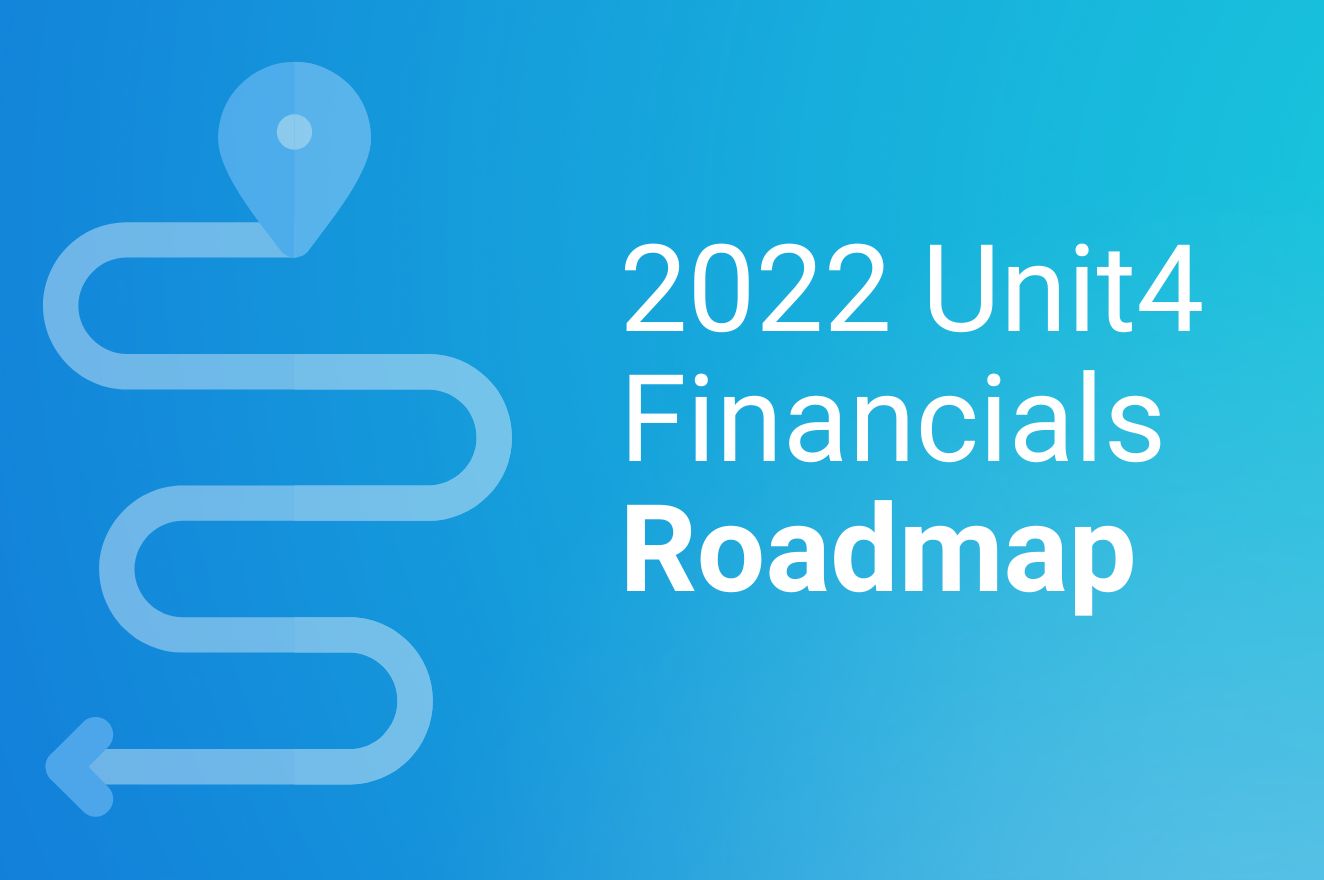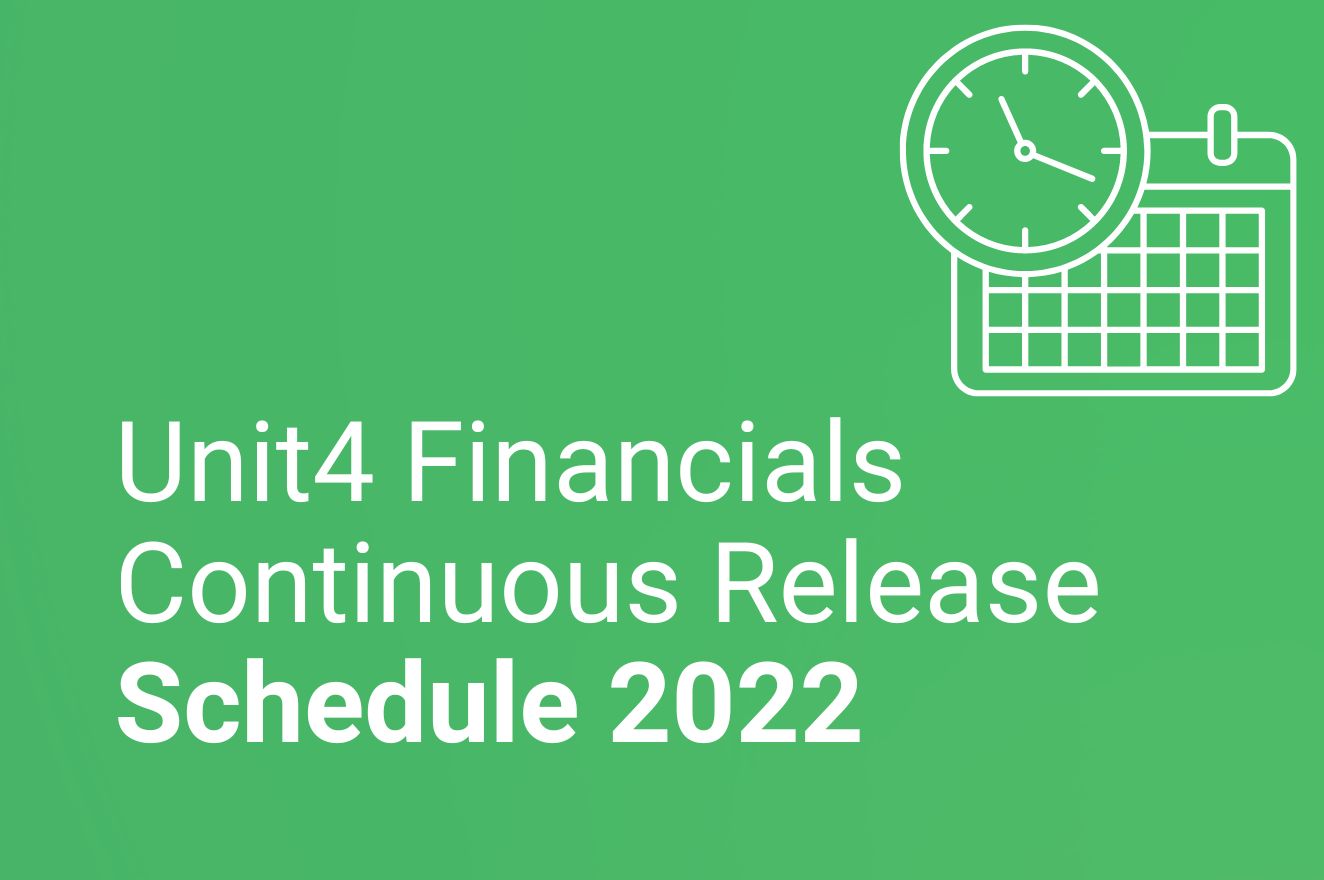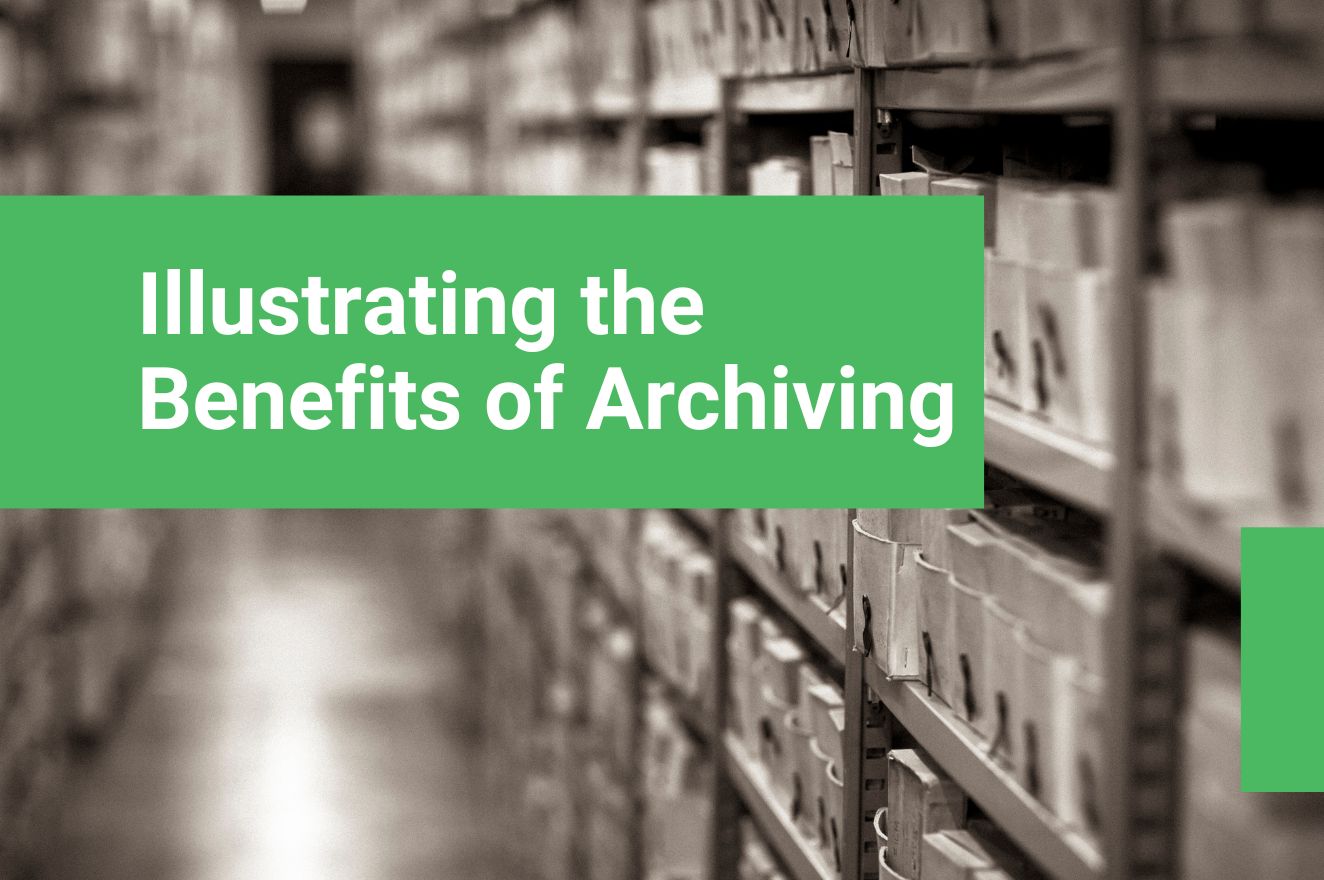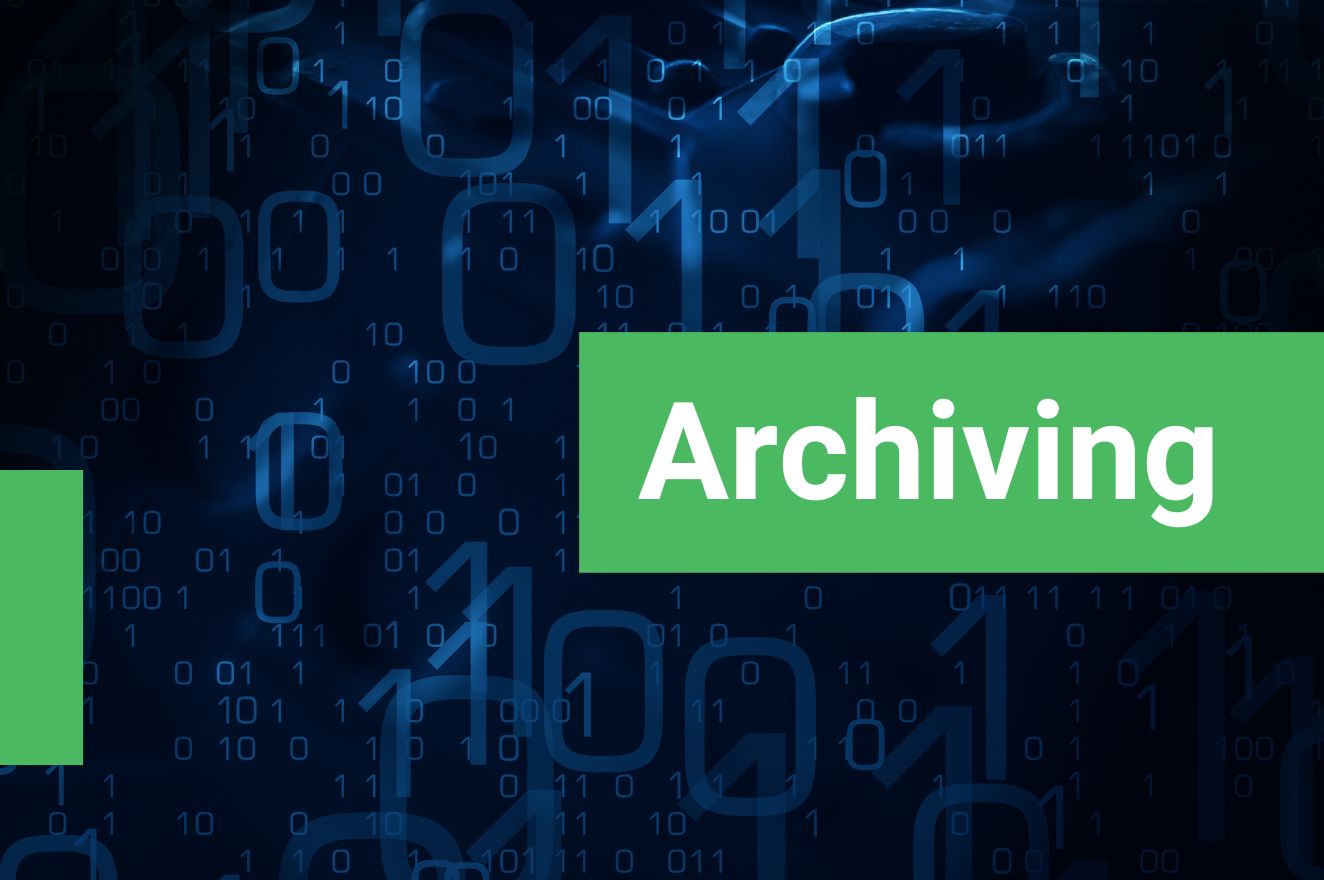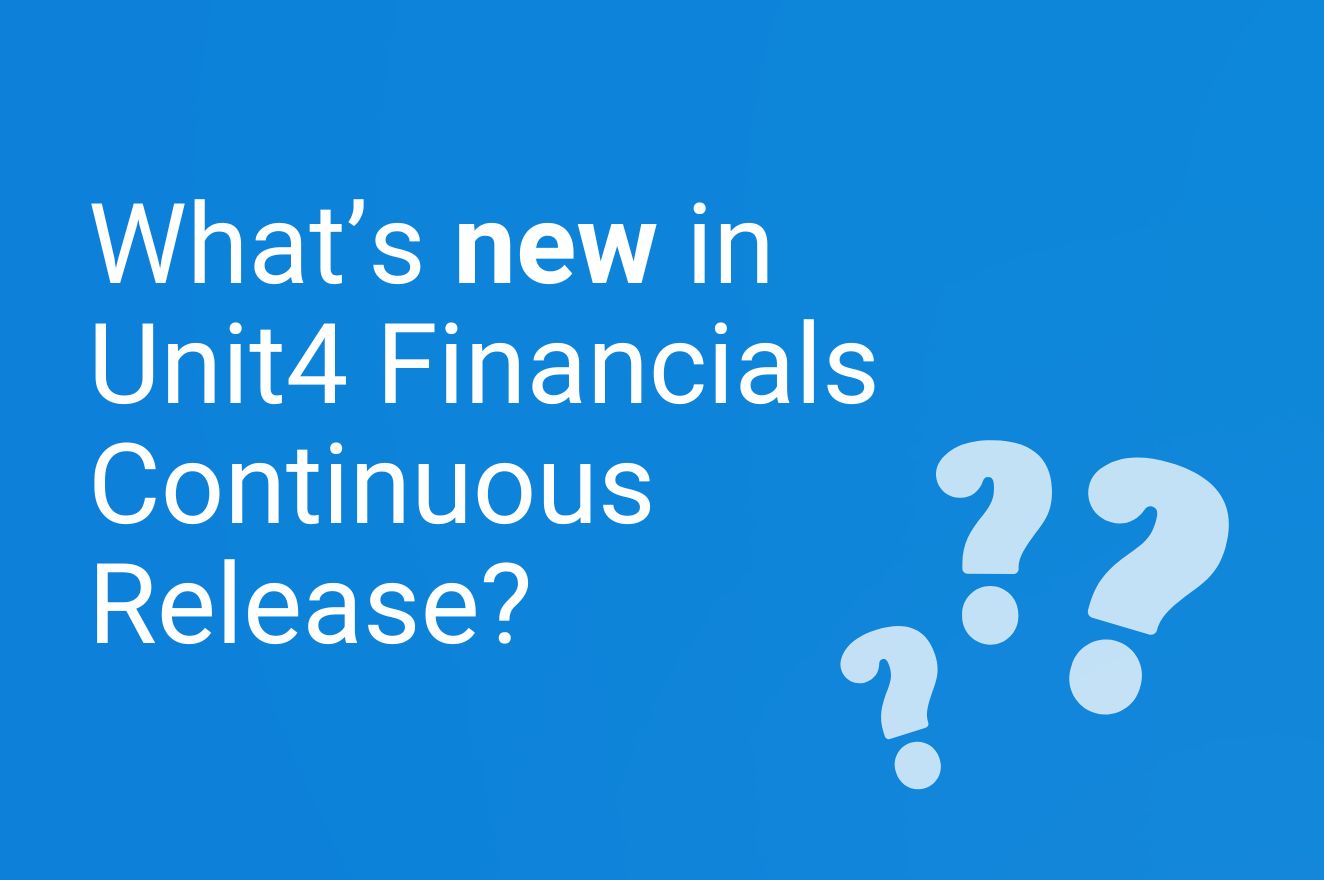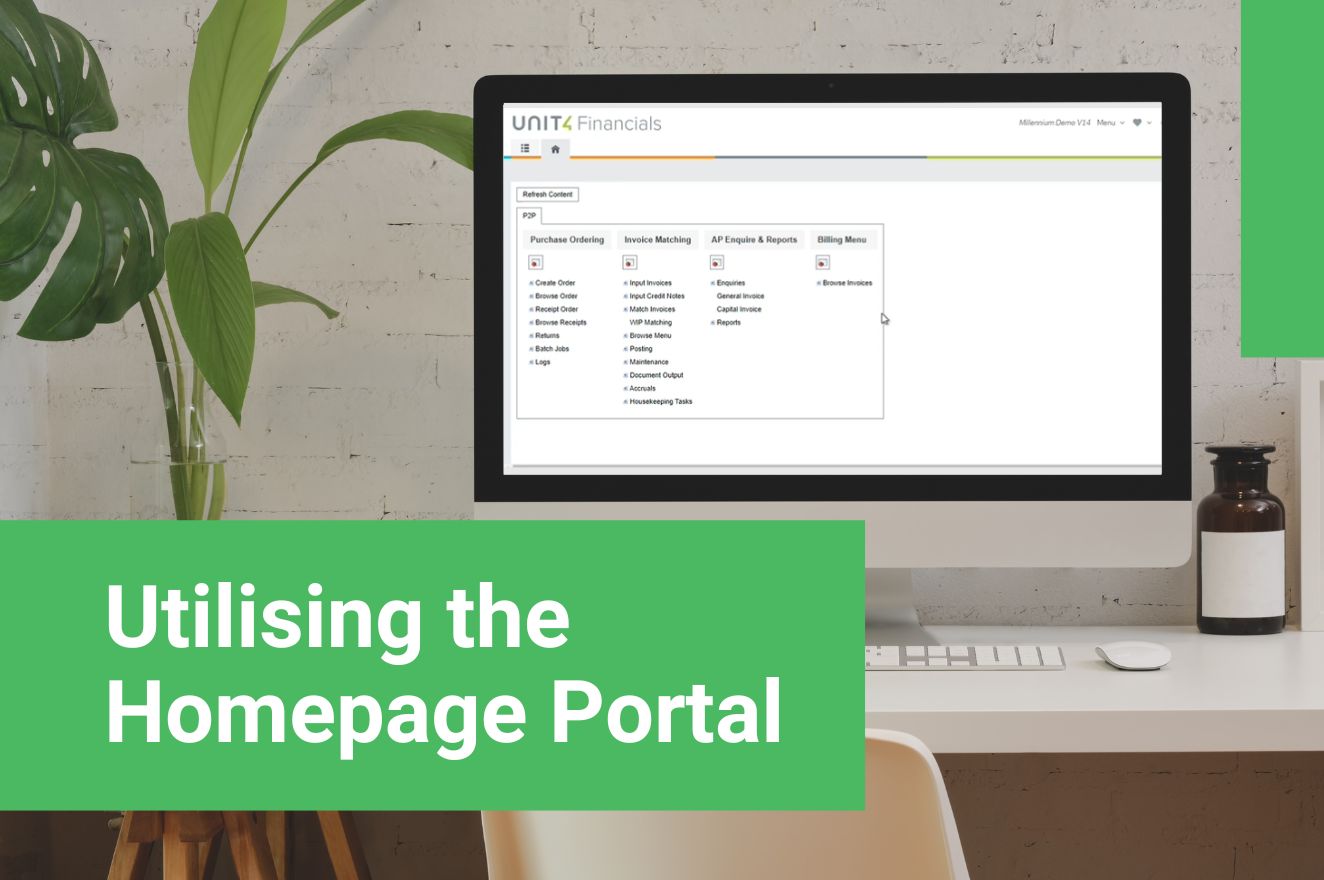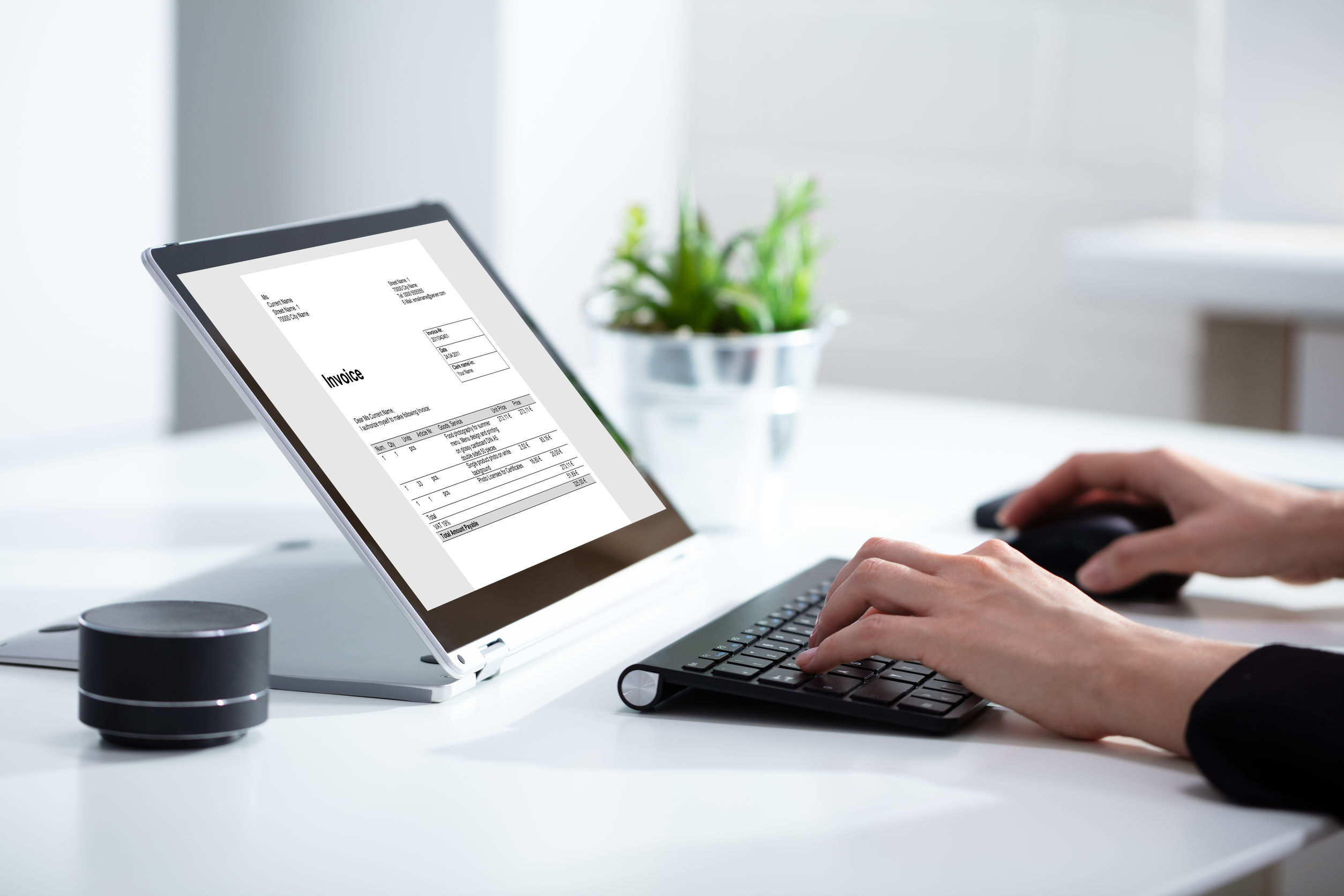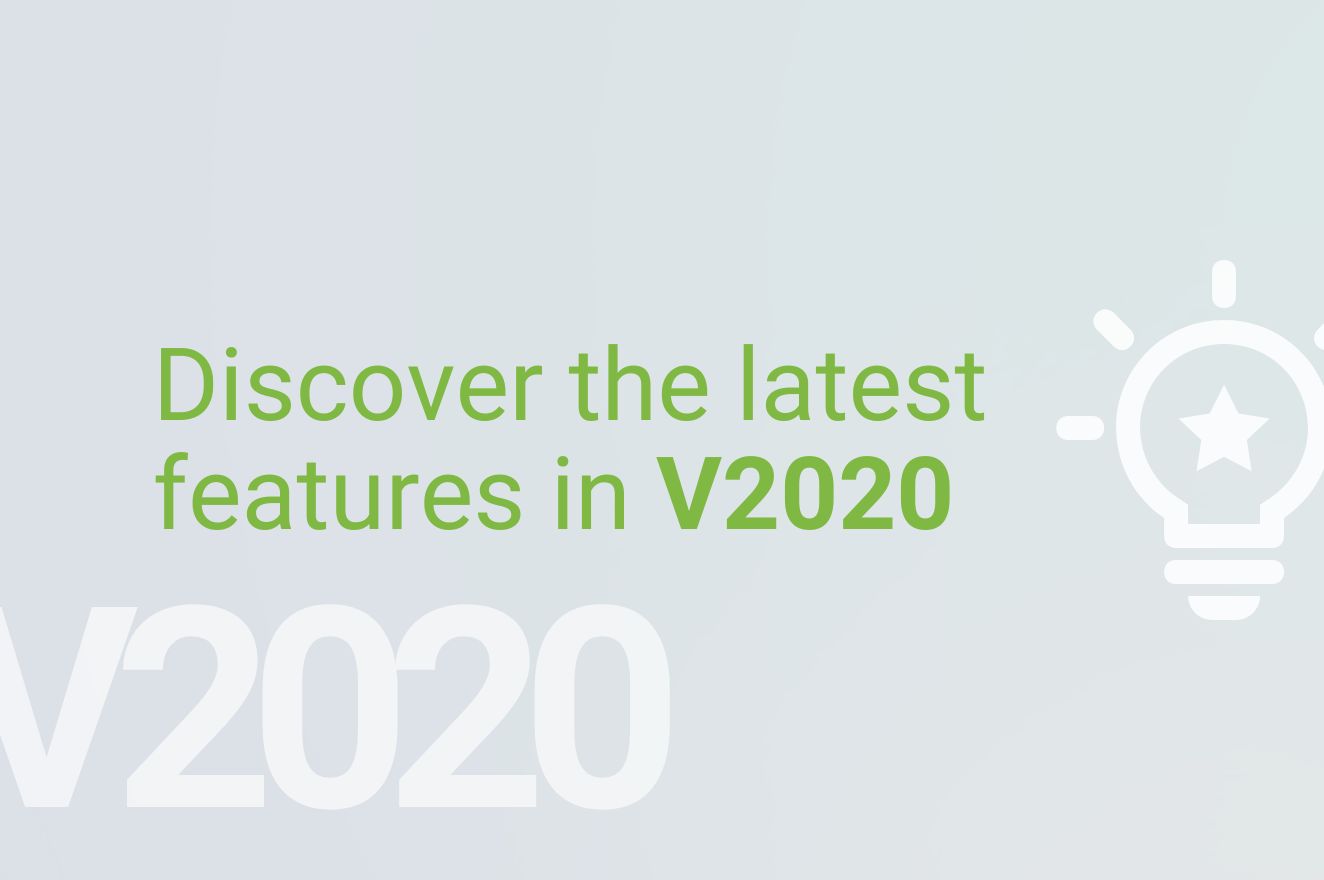2022 Unit4 Financials Roadmap
February 2022
2022 Financials Roadmap
The Unit4 Financials continuous release model helps to ensure that finance departments are equipped to handle their most pressing operational challenges. This includes new regulations, volatile market conditions, and internal pressures to do more with less.
To ease your transactional workload, 2022 looks set to see the introduction of some welcome additions to the Unit4 Financials platform. Here’s a closer look at what’s in the update pipeline.
One of the most attractive features of Unit4 Financials is its multi-everything design (country, company, currency, tax, language), ensuring the ability to handle even the most complex or evolving corporate structures.
You can run your system as a single version worldwide, thereby ensuring consistency and visibility across the enterprise. But alongside this, you also get the flexibility to satisfy a huge range of local statutory and accounting approaches found around the world.
We are set to see further evidence of this ‘global yet local’ approach in 2022. A prime example comes in the form of new structured output for closer integration with ELSTER, Germany’s electronic tax return system.
The solution already includes the ability to produce invoices in an xml format. Unit4 is in the process of enabling this with billing, also.
The solution should also shortly accommodate QR codes on print formats.
For auditing and general ease of admin, life becomes so much easier if you can save actual billing documents within the platform itself. Unit4 added attachments to billing in early 2021. They are now going a step further, enabling you to copy those attachments over to the Financials document.
The last couple of years have seen a gradual extension of Financials’ ‘scheduled tasks’ functionality, (hierarchy updates, asset depreciation and reconciliation are a few recent examples). Driven by customer demand, you will also shortly be able to add a scheduled task for the Open/Close Period.
A new Supplier Filter will be added to procurement.
Future vision for 2022 and beyond
This functionality is already available with an on-premise set-up, Unit4 is looking at creating a cloud version.
Introduced in Continuous Release 2020, tablelink for cloud gives you an on-premise version of your link tables, and an API that takes the data into the cloud. Expect further enhancements to this function over the coming years.
• Define name for email attachments
Certain activities within the product involve emailing attachments to customers or suppliers (invoices and statements, for instance). This upcoming new function enables you to define the names of these attachments. This can be useful for preventing the messages from being caught by user email filters.
• Expiry for element banks and addresses
You will shortly be able to expire a bank as against a customer or supplier account. You can still see it (but not use it) when inputting your documents.
• Specify address for email output
At the moment, the system picks up the default email address for a customer or a supplier account. Unit4 looks set to make it easier to send different categories of communications to different email addresses within the same customer organisation.
• Copy company set open number range
It will shortly become easier to copy and move defined extracts of company information.
Areas of focus for Unit4 over the next few continuous releases include:
• Support for Wildfly 25
• 3rd party library updates
• Corrective maintenance
Seamless interoperability with business applications of all types is a further major benefit of the Financials product. Building on this, Unit4 will be looking to introduce further ways to integrate Financials with the Microsoft Office 365 suite. Other technical enhancements include the following:
• Clustering performance
• Cloud SaaS improvements
• Cloud product usage
• Rationalised and centralised DB access
• A simpler cloud deployment system
• Upgrade script improvements
• Audit trail upgrade improvements
• Download xml client libraries
• Alternative document repository
• People platform integration
Important upgrade information
Support for Unit4 Financials V13 has already been withdrawn. Support for V14 will expire at the end of 2022. Failure to upgrade before then increases the likelihood of incurring extended support charges from Unit4.
Upgrading enables you to:
• Access the latest functionality
• Reduce operational risk and processing costs
• Continue to access Unit4’s “in support” software maintenance and support package
• Ensure you are up to date with Unit4’s latest software security package
As an Elite Unit4 Partner, Millennium Consulting specialises in delivering a seamless upgrade, while also ensuring your upgraded solution is fully aligned with organisational requirements.
To explore your options in Unit4 Financials, contact us today.
Unit4 Financials Continuous Release Schedule 2022
February 2022
Unit4 Financials Continuous Release Schedule 2022
The Unit4 Financials platform is maintained via a continuous release model. Thanks to this predictable cycle of quarterly updates, users get timely access to the type of customer-driven enhancements that helps to keep the finance department ahead of the game.
Read on to find out when Financials updates are scheduled for 2022, along with important information for legacy V13 and V14 users.
Unit4 Financials planned releases
| 2022Q1 Release | Planned 8 March 2022 |
| 2022Q2 Release | Planned 7 June 2022 |
| 2022Q3 Release | Planned 13 September 2022 |
| 2022Q4 Release | Planned 6 December 2022 |
These dates can sometimes be subject to alteration.
To read a summary of what has been added since October 2020, along with a closer look at some of the most noteworthy enhancements, read What’s new in Unit4 Financials Continuous Release?
Post release, an .iso for each release is available from the Software Distribution Server.
Information for V13 users
V13 was previously maintained via Service Pack updates. The last Service Pack (23) was released on 27 September 2019. These previous updates are still available to download on the Software Distribution Server. No further Service Packs for V13 will be forthcoming.
Discover the latest Unit4 Financials features in V13 here.
Please note that maintenance for V13 was retired in February 2021.
No critical bug fixes for this product are being issued.
Information for V14 users
V14 is maintained via a full re-release of the software on .iso, available from the Software Distribution Server. The most recent V14 Release Pack – Release 17 – was made available on 28 November 2021.
Future Releases for 2022 are still to be confirmed (at time of writing) and will be dependent on user demand and the nature of any issues that arise.
Discover the latest Unit4 Financials features in V14 here.
Please note that maintenance for V14 will cease at the end of December 2022.
Distribution and notification of cloud updates
Unit4 Cloud customers are notified by Unit4 Cloud support when their pre-production and production systems will be updated. This information can also be found within the Cloud Services – Release Schedules area.
Updating your legacy systems
Support for Unit4 Financials V13 has already been withdrawn. Support for V14 will expire at the end of 2022. Failure to upgrade before then increases the likelihood of incurring extended support charges from Unit4.
Upgrading enables you to:
- Access the latest functionality
- Reduce operational risk and processing costs
- Continue to access Unit4’s “in support” software maintenance and support package
- Ensure you are up to date with Unit4’s latest software security package
As an Elite Unit4 Partner, Millennium Consulting specialises in delivering a seamless upgrade, while also ensuring your upgraded solution is fully aligned with organisational requirements.
Is it time to upgrade?
Upgrading your finance software can provide new functionality, increased automation and more efficient processes.
Illustrating the Benefits of Unit4 Financials Archiving – A Case Study
January 2022
For customers with high transactional volumes, the adoption of best practices around Unit4 Financials archiving allows them to significantly improve system performance and save storage space. A recent project undertaken by Millennium Consulting demonstrates the positive impact of archiving for Unit4 Financials users.
Read on to discover what we found, along with practical tips on addressing common archiving issues.
A case study in focus
Recently, Millennium Consulting undertook a company archival project for a global player in the pharmaceutical industry. The period covered was from 1995 to 2015.
The archiving exercise revealed that more than half of the documents within the organisation’s database were capable of being stored more efficiently.. Through the project, we were able to free up a significant amount of disk space within the production database but more significantly, we de-risked the organisation’s accounting solution against performance degradation over time.
At the conclusion of the project, we found that the archive tables on the database amounted to a significant 2.2GB of space. In total, 821,773 documents were archived representing 58% of the total documents within that company.
Most of the customers we speak to say that the volume of financial data they are processing is growing year by year. This is partly down to organic development, i.e., as an organisation matures, the number of transactions it is involved in intends to increase as a matter of course. But other trends are also in play here. Notably, for compliance and performance management reasons, businesses recognise the value of capturing a much wider range of granular data relating to individual transactions. The flipside, of course, is that more data means a greater burden on storage capacity and system performance.
What do we recommend?
• Archive all dormant companies, initially to the internal database using arc tables. Straight after internal archiving, you can then transfer these tables to the external archive database.
• Externally archive all live companies, except for the last four or five years. Again, you need to archive internally before transferring the tables to the external database.
• Archive to the internal database all live companies, apart from the last two full years.
• We recommend leaving in the current books all live companies for the last two full years.
If you follow this approach, then at each financial year end, you need to undertake the following:
• Archive to the internal database the third oldest year (e.g., at the end of 2021, you would internally archive 2019)
• Archive to the external database the sixth oldest year (e.g., at the end of 2021, you would externally archive 2016)
Find out more
You can learn more about the archiving function for Unit4 Financials in this brief demonstration video:
As an Elite Unit4 Partner, Millennium Consulting provides expert input to ensure Unit4 Financials is fully aligned to your organisational requirements. For help with archiving a backlog of legacy data, devising an archive policy, or optimising your existing archive processes, speak to us today.
Benefits of the automation of manual processes in Unit4 Financials
23 ways to automate and reduce cost and risk, by setting up the automation of manual processes in Unit4 Financials
January 2022
Workflow
With more people working remotely, re-configuring workflow allows organisations to keep efficient by ensuring each process is streamlined and everyone interacts with the process at the right time.
Banking payment XML
Reduce manual effort by setting up XML bank payment files.
Intercompany PO’s
Setting up intercompany PO’s will stop the need for companies to raise separate PO’s one-by-one in each company. With the Intercompany facility it is possible (for example) to raise a PO in one company that is for goods services in two other different companies.
Unit4 XL reporting
Set up reports in Unit4 XL for real-time reporting from Unit4 Financials and reduce any unnecessary manual Excel work.
Auto VAT Calculation
VAT can be calculated automatically based upon the VAT code being supplied – therefore reducing the input burden being placed on the user.
Derived fields
The entry of documents can be assisted greatly using derived fields on the input templates. This can automate the population of many of the fields on the Input screens which will speed up data entry and enhance the user experience.
Allocation
Allocation provides a flexible, automatic means of allocating centrally incurred costs across an organisation's operating units, so reducing manual work.
Currency Revaluation
The automation of currency revaluation enables you to recalculate home (GBP) values based on foreign values. The foreign values are selected, either from details or from balances, for reconversion at new exchange rates.
Account Summaries
Account summary is a user configured enquiry form that allows information from suppliers to be brought together with transaction details, balance, and diary information to produce a single view of the data.
Electronic remittances
In Continuous Release, electronic remittances can be generated automatically by email during a payment run.
Element Authorisation
Element authorisation can be used to automate new vendor and/or customer authorisations and creation.
Automatic accruals
There is an automatic routine within the invoice matching module that can create accruals and post to the financials module, so reducing month end effort.
Archiving
Archive enables the user to remove old data from the books to an internal archive area within the database. The archive process improves the system performance experienced by a user by reducing the amount of information held on the books.
Attachments
The attachments framework allows a user to attach documentary evidence to element masters, financial documents, purchase orders and sales invoices. The information can be in a variety of formats eg spreadsheet, PDF, Word etc that provides working papers or backup to a transaction. Once attached, the user can also view, remove, or replace the attached file.
Service Desk
Reduce cost and risk with Unit4 Financials Support and Maintenance from the Millennium Service Desk team.
Interface Manager
Interface Manager gives control back to the finance team to run and schedule their own interfaces so alleviating members of the IT department of doing these tasks.
Unit4 Travel & Expenses
Streamline and automate the expenses process, giving you more control over costs, better enforcement of company policy and help reduce the time and effort it takes to process employee or subcontractor expenses.
AutoCash
Save time and effort by automating your bank statement processing – automatically load, post, match and reconcile any items on your Bank Statements with transactions recorded in Unit4 Financials.
Unit4 Purchasing & Invoice Matching
Enforcing the authorisation and control over expenditure at the start of the process, rather than after the fact on receipt of invoice helps companies to stick to their budgets, control costs and gain efficiencies from better supplier leverage.
Unit4 Invoice Capture
Unit4’s Invoice Capture automates the capture and posting of invoices through intelligent OCR scanning and posts directly into Unit4 Financials.
Data Cleansing
Data cleansing removes major errors and inconsistencies that are inevitable when multiple sources of data are pulled into one dataset. Using tools to clean-up data makes the process more efficient since you will be able to quickly get accurate information into your system of choice.
Asset uploading
Do you regularly need to upload assets into Unit4 Financials fixed assets module – if so then Millennium’s Asset Uploader can streamline this process to help ensure all your assets are loaded error free.
Data Migration
Migrate your data between systems or to the Cloud, giving you quicker integration, faster implementation, and reduced risk.
Contact us for further details
Looking for ways to automate and reduce cost and risk? Submit your details and one of our experts will be in touch.
Archiving for Unit4 Financials
Archiving for Unit4 Financials
With any accounting or financial management solution, regular archiving helps you keep control over the size of your datasets, speed up processing times and ensure ongoing optimum software performance.
In this blog post, discover how archiving works in Unit4 Financials by Coda and the difference between the two types of archiving available.
What are the Archiving options in Unit4 Financials?
There are two types of archiving:
Internal archiving
With internal archiving, information continues to reside within your main Unit4 Financials production database.
Tables in the internal archive are given an “arc” prefix. The transactions within these internally-archived tables can still be accessed through enquiries. To search archived items, all you need to do is change your selector to ‘archive’ instead of ‘books’.
External archiving
External archiving involves moving data from the Unit4 Financials production database to a separate archive database. Note however, that this archive database still resides on the same database server. As with internal archiving, externally archived data is held in “arc” tables. To do external archiving, you first must do internal archiving.
How to utilise Archiving for Unit4 Financials
With any accounting system, the larger the dataset, the longer it takes to process requests (e.g. queries, searches and transactional reports). Especially if your Unit4 Financials users are experiencing a gradual drop-off in response speed over time, it’s a sign that archiving is likely overdue.
To avoid having to routinely process potentially millions of lines of irrelevant data for each request, it’s certainly worth focusing on the following:
• Establishing an archiving policy
Matters to consider here include whether and how often users need to query data that is over a year or two old. You should also look at how often your AP/AR teams need to query transactions paid/matched over a year ago.
• Ensuring a correct archiving set-up
As a start, you need to ensure the archiving feature in your Unit4 Financials system has been activated and configured according to your needs.
Does archived data remain accessible?
In short, yes. When you have archived your data in Unit4 Financials, that data remains searchable.
When you submit a query on the system, you have the option to search live data only, or include archived data. For most users, the majority of day-to-day queries relate only to recent data. So for these queries, users can stick with the default live data search setting. Regular archiving means that the system does not have to trawl through swathes of irrelevant data, thereby helping to maintain optimal search response times on routine tasks. On those occasions where you need to check historical data, you can simply switch the query type to include archived information.
Unit4 Financials Archiving: Watch how it works…
This brief video further illustrates the differences between each archiving method to help you choose between the two. It covers the issues that commonly arise in archiving financial information and how you can resolve them within the system. We also share a case study illustrating the benefits of archiving.
(Published January 2022)
As an Elite Unit4 Partner, Millennium Consulting provides expert input to ensure Unit4 Financials is fully aligned to your organisational requirements. For help with archiving a backlog of legacy data, devising an archive policy, or optimising your existing archive processes, speak to us today.
What’s new in Unit4 Financials Continuous Release?
December 2021
What’s new in Unit4 Financials Continuous Release?
New functions rolled out under recent Unit4 Financials quarterly releases have significantly enhanced the user experience, further enabling your finance team to streamline business processes, reduce operational risk and free up resources for value-added work.
Here’s a summary of what has been added since October 2020, along with a closer look at some of the most noteworthy enhancements…
At a glance: release date summary
| CR 2021 Q4 (7th December 2021) |
| CR 2021 Q3 (14th September 2021) |
| CR 2021 Q2 (9th June 2021) |
| CR 2021 Q1 (9th March 2021) |
| CR 2020 Q4 (8th December 2020) |
| CR 2020 Q3 (14th October 2020) |
| V14 R16 (27th July 2021) |
| V14 R17 (end November 2021) |
- Hotfix to protect Unit4 Financials in the Log4j Java library
- Table Link Transfer Client
- Billing: Use Structured Output on Final Issue
- Billing: Copy Attachments on Posting
- Invoice matching: Set number of background matching threads
- Structured Output – UBL 2.1 Transformation: XML can be validated against the UBL 2.1 Invoice schema
- Attachments can now be managed from within the Billing Browse screen
- It is now possible to attach the PDF Invoice or Credit Note to the Billing document on final issue
- Scheduling a task of type Print Invoices now permits you to generate structured output for invoices (for example, XML in UBL 2.1 Transformation)
- Purchase orders approval can now be viewed across company in read-only mode
When you save masters, trailing spaces are now automatically removed. Print invoicing functionality is also improved, including support for XML formatting, as well as for invoices in pdf format.
- Documents outputs can now be written to an SFTP location
- Leading and trailing spaces are automatically removed when updating master names and short names
- The ‘Print Invoices’ function now allows an XML invoice. Transformation to be generated and sent. A pdf from a print format can be attached to the Finance document as its primary attachment
- The ‘Remove’ checkbox for additional lines in input is now positioned on the right-hand side by default
- Structured Output – UBL 2.1 Transformation: the generated XML file is now validated against the UBL Invoice schema
- Structured Output – UBL 2.1 Transformation: new vocabulary available including IBAN, attachment ID
This release included a number of enhancements that actually go a long way in improving the user experience. Examples include the new option to sort a paylist in descending order. There is also a new ‘element authorisation status’ for the financials selector master, which means that an element that isn’t authorised for changes can be excluded automatically without having to send a reminder or statement.
- Download XL for Unit4 Financials
- Document master setting to prevent the user who originally posted a document to the intray from posting the document to the books
- Pay/Collect summary now displays the pay proposal list by Pay Date in descending order
- Element authorisation status added to financials selector master
- New Punchout parameter added, user email
- Review Punchout items screen has new ‘select all’ and ‘deselect all’ buttons
- Punchout website now appears in a new tab in the browser
- Structured Output has a new transformation available, called ‘FEC’ Transformation (Fichier des ecritures compatables)
- Structured Output now allows zip file compression
- Structured Output can now generate .csv files without quotes
The new Tablelink for Cloud feature helps to simplify cloud migrations, removing the need to rewrite interfaces using web services and APIs. The release also included SFTP support, along with the ability to create comma-separated files that can be transported. e-Invoicing capabilities were also enhanced.
- Structured Output – CSV Transformation
- Structured Output – Output to SFTP
- Structured Output – Output to HTTP POST
- Tablelink for Cloud – Helper and API
- Improvements to upgrade Scripts
- e-Invoicing enhancements (Dutch XML invoice load)
- Unit4 Financials Idealization Process
Version 14 of Unit4 Financials saw the introduction of a new billing module. Among other enhancements, the 2020 Q3 continuous release saw an extension of these billing features.
- System users with OpenID Connect
- Billing – Quantities copied to Finance
- Billing – Print Preview
- Structured Output – Message Hub Output
- Unit4 Extension Kit – Samples
- Structured Output – GDPdU (local German product)
Having introduced a wide range of new features in the previous quarter, the 2020 Q2 release was focused mostly on routine product maintenance. However, there were a couple of new functions added. These were a scheduled task for reconciliation, along with changes to the Avalara export to accommodate HMRC’s ‘Making Tax Digital’ initiative.
- Scheduled task for Reconciliation
- Structured output changes – Avalara XMI export
This was the first release under Unit4’s new quarterly roll-out model (‘Continuous Release’). It introduced a wide range of new features.
- Schedule Task for hierarchy updates. You can now schedule new tasks for hierarchy updates and asset depreciation
- Submit orders on auto convert from requisitions
- Browse Transactions: Raise Corrective Journal
- Browse Transactions: Copy Document
- Deep link ‘balance’ drill to browse transactions
- Schedule Asset Depreciation
- Element template customisations copied via copy company. Element template customisations are now copied via the ‘copy company’ functionality
- Billing Copy Document
- Reconciliation Date & User. The introduction of this feature allows users to do retrospective reconciliation reports. In addition, the same level of functionality available in ‘browse details’ has also been extended to ‘browse transactions’
- Browse Transactions: Drill to Account Summary
- Browse Transactions: Edit Comment via related information panel
- Browse Transactions: Workflow Actions
- Provisional and Undo Year-End. Learn more about these features here
- Migrate customisations from test to live
- Allow change to balances on company master
- LRN Housekeeping without posting
- Reference Attachment Hyperlink as Direct Link
- GDPR for Element history
- Make use of address categories in Procurement Ordering
- Add Element Flexi-Fields data to Copy Company
- Change Pay Period. This is the ability to be able to change the period during a pay proposal
- Interco control to contain customer/supplier elements
Should you upgrade your Unit4 Financials software in 2022?
Support for Unit4 Financials V13 has already been withdrawn. Support for V14 will expire at the end of 2022. Failure to upgrade before then increases the likelihood of incurring extended support charges from Unit4.
Upgrading enables you to:
- Access the latest functionality
- Reduce operational risk and processing costs
- Continue to access Unit4’s “in support” software maintenance and support package
- Ensure you are up to date with Unit4’s latest software security package
As an Elite Unit4 Partner, Millennium Consulting specialises in delivering a seamless upgrade, while also ensuring your upgraded solution is fully aligned with organisational requirements.
Unit4 Financials Continuous Release: Provisional Year End and Year End Undo
November 2021
Unit4 Financials Continuous Release: Provisional Year End and Year End Undo
Here’s a closer look at the latest version’s new Provisional Year End and Year End Undo functions, and the benefits these will bring to your reporting procedures.
So, what has changed?
- A new Provisional Year End function. This performs all the processing of a full year end, but without closing the year in question, so you can continue posting to that year.
- A Year End Undo function. You can now undo a year end after it has been closed. Having effectively unlocked it, you are then free to post to the year in question.
Provisional Year End function
This new provisional mode option gives organisations more control over year-end. No longer do you have to wait for the auditors to give the green light before running a ‘once-and-for-all’ process. Instead, you can create and update a provisional version at any time within the system, and subsequently close it when you are ready.
If a requirement for further adjustment is flagged up after close, the undo function makes it easy to rectify it.
The new functionality is only available to users who have upgraded to Unit4 Financials 2020 / Continuously Release (previously known as Version 15). Under this latest software version, users have a choice of two modes for running a year end: provisional or full.
Undo Year End function
The new undo year end feature in Unit4 Financials Continuous Release is a further useful addition to the system’s functionality. It means you can now undo both provisional and full year ends.
When activated, the undo function cancels all year end journals posted to the final period for the latest year in which a year end has been run, as well as to the opening period of the following year. If a full year end is undone, then the minimum year will be reset to the previous year.
Benefits for finance teams
The new provisional mode gives finance officers a much greater degree of flexibility in the timing of their year end process.
Previously, launching the year end process always meant closing the year, which in turn generally meant the process could not be triggered unless and until the auditors had completed their final checks. Now, you have the option of running a report at any time of your choosing. As well as being a useful internal resource for finance, there may also be wider situations where the ability to rapidly generate a provisional year end will be useful, such as updating the executive team or providing information to external stakeholders.
Furthermore, year end close traditionally meant that the accounts for the year in question were locked down for further adjustments. The undo year end function provides a useful failsafe measure: if a discrepancy is discovered further down the line, you have the option of rectifying it quickly and easily.
Watch these new functions in action
A painless Unit4 Financials upgrade starts here
Are you currently running Unit4 Coda Financials V13 or earlier? With support for these legacy versions now withdrawn, this is the time to upgrade.
Millennium Consulting specialises not only in ensuring the upgrade process is a seamless one, but also in ensuring your upgraded solution is fully aligned with what your organisation wants to achieve. To explore your upgrade options, contact us today.
Is it time to upgrade?
Upgrading your finance software can provide new functionality, increased automation and more efficient processes.
Utilising the Homepage Portal in Unit4 Financials
November 2021
In this blog post discover how the Unit4 Financials Homepage Portal can transform the user experience, enabling easier navigation, faster processing, and more effective day-to-day task management.
The Homepage Portal is available on Unit4 Financials V12 onwards.
If you are a user who has been allocated a Homepage Portal, your default screen when logging onto the system will look something like this:
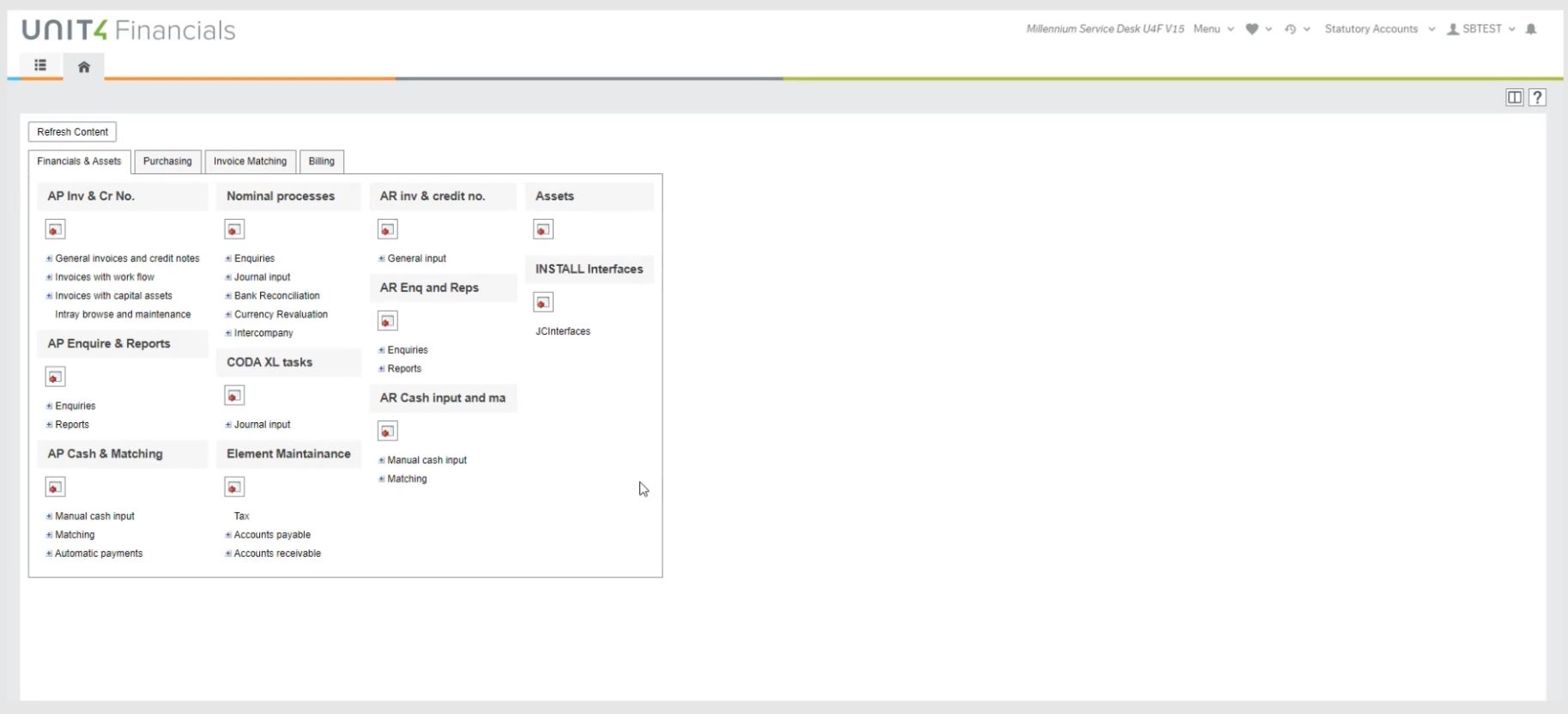
It’s refreshingly simple, comprising of three elements:
Tabs. The tabs are pages relating to distinct operational areas; in this case, Finance & Assets, Purchasing, Invoice Matching and Billing. The Portal is completely customisable, so you can match the tabs to the individual user’s role and responsibilities. For example, in the case of a team member whose sole responsibility is administering incoming invoices, the portal might include just a single tab: Accounts Payable.
Frames. The frames are used to group together similar content providers (see below) by subject area.
Content providers. Clicking on a content provider will take you directly to a specific report or function. For instance, under the Nominal processes frame within the Finance & Assets tab, a user can instantly navigate to Enquiries, Journal Input, Bank Reconciliation, Currency Revaluation or Intercompany Adjustments, simply by clicking on the relevant content provider.
Watch how the Portal speeds up task performance
Watch a demonstration of a search carried out from the main menu, and the same search executed via the Portal model.
The Portal approach is significantly more effective at taking users exactly directly where they need to be. There’s far less manual entry and toggling through presenters and selectors. On an individual user level, it’s quicker and easier. And once you apply it to a large finance team, all of whom execute dozens of processes and queries a day, it can make a huge difference to organisational productivity.
Portal setup
Portals are set up at system administrator-level. Before you start to set up a Portal, we recommend that you have a sketch map of the way you want the menus to be displayed, and the content.
Unlocking Unit4 Financials expertise
If you would like expert input on Homepage configuration, we’re here to help.
Whether you are looking for ‘easy wins’ from your existing setup, best practice advice on the platform’s latest functionality or a complete re-implementation, Millennium Consulting can provide the support you need. To access unrivalled expertise from a Unit4 Elite Partner, speak to us today.
Is it time to upgrade?
Upgrading your finance software can provide new functionality, increased automation and more efficient processes.
Five Solutions to Streamline your Accounting Process
Five Solutions to Streamline your Accounting Process
February 12th, 2021
Even with the power of Unit4 Financials at your fingertips, there are still several ancillary processes that exist within the finance ecosystem that can benefit from greater automation and streamlining.
From invoice matching to document scanning, discover the modules and add-ons that can drive efficiency and reduce operational risk in your finance function.
1. Purchase Order Processing (POP) / Purchase Invoice Matching (PIM)
Unit4 Financials Purchase Order Processing (POP) and Purchase Invoice Matching (PIM) enable you to better understand, control and manage costs.
The modules provide improved invoice matching, budgetary control and cash flow forecasting to help you:
- Approve costs before incurring them
- Enhance internal controls
- Take committed costs into account
- Consolidate your costs
- Improve your reporting output
POP and PIM enable you to make better decisions and increase project profitability across your finance function.
2. Billing
Fully integrated with the core Unit4 Financials framework, the Billing module simplifies your invoicing process – removing the need for integrations with third- party billing systems.
The user-defined product catalogue, with individual item characteristics and rules, ensures accurate, complete and up-to- date data in your invoices and general ledger.
You can also easily design invoice templates, define invoice layouts and statements.
The module provides you with:
- Item Catalogue for Purchasing & Selling
- Drag and drop functionality to design and customise the layout of screens
- Configurable data entry screen
3. MBilling Icorp
For firms that require complex functionality (or need to send out high volumes of sales invoices), a comprehensive sales invoicing/ billing solution is essential.
Seamlessly integrated into Unit4 Financials, MBilling powered by Icorp supports high-data volumes and contains powerful billing / sales invoicing functionality – including a comprehensive rules engine, smart algorithms and data bridging.
Transform your accounting processes with intelligent software that can extract information from any source system, reducing operational risk and improving efficiency.
4. Invoice4 Document Scanning & OCR
Transform your approach to the Accounts Payable process with Invoice4, enabling you to receive 100% of your invoices electronically from day one.
By directly receiving purchase invoices (whether paper, PDF, email, XML or EDI), Invoice4 introduces a new starting point. It allows you to view accurate, cleansed electronic invoices from your existing Unit4 Financials system without the need for extensive data entry and associated errors.
Fully integrated and certified, the solution provides the lowest risk and most cost-effective means of capturing purchase invoices, giving you a great head start in processing invoices with the highest levels of efficiency and effectiveness.
5. Digital Invoicing
Digital Invoicing gives you an efficient method for transmitting and storing invoices – streamlining your Sales & Purchasing processes.
It also helps you to reduce the use of paper and the associated costs of printing, shipping and storage.
The module allows you to produce, transmit and store electronic invoices in XML format – giving you greater control over the elements contained in each document.
It provides you with the ability to map and post incoming invoices into Unit4 Financials, while producing XML files from outgoing invoices.
Contact us for further details
If you would like any further information on this subject, please submit your details and one of our experts will be in touch.
Discover the latest Unit4 Financials features in V2020
Discover the latest Unit4 Financials features in V2020
This post shares all the functionality available on Unit4 Financials V2020. If you are upgrading from an older version of Financials, you will get all of the below features plus all the very latest features from V13, V14 and Continuous Release.
The naming convention may have changed, but the latest version of Unit4 Financials offers all the new features you would expect. Unit4 Financials V2020 (rather than V15) is available now.
If you are on V14 remember that at end of 2022 it will fall outside the Unit4 supported software window. If you don’t upgrade before that date, you may incur extended support charges from Unit4.
Now may be an ideal time to look at the options that are available to you and the benefits you will gain from an upgrade.
New features arriving in V2020 include:
- Element Authorisation
- Change Log Anonymisation
- Provisional Year End
Plus a wide range of technical improvements…
Along with the additional functionality, V2020 brings a new approach to regular updates – adding a version number to the end, based on the quarter it is released in. For example, the current release is V2020 Q3.
It is also important to note that V13 and all previous versions of Unit4 Financials will no longer receive full support.
What's new in V2020?
Full Year End
- Sum all the profit and loss accounts, posting the NET figure to retained earnings in the balance sheet
- Post the closing balance sheet figures to the period 0 of the following year
- Close the year of the Year End being processed, preventing any further postings
Provisional Year End will perform all the processing of a full Year End, but will not close the year being ended, allowing you to continue posting to that year.
Any subsequent Year End processing will perform incremental postings for those applicable to the year being ended. These postings will have an input date greater than the one specified for the last provisional Year End.
Example: If your Year End is 31st December, you can run the process before 31st January in provisional mode, so that your balance type reports will capture carried forward balances in period 0 when you run period end reports for period 1.
Undo Year End
You can now undo both provisional and full Year Ends. This will cancel all Year End journals posted to the final (9999) period for the latest year in which a Year End has been run, and to the opening (0) period of the next year.
If a full Year End is undone, the minimum year will be reset to the previous year. The Undo Year End process undoes all the Year Ends that have been run in the selected year, not just the last Year End process itself.
Example: If you undo the year 2019 in 2020 (having also run 2017 and 2018 Year Ends in 2020), it will undo all three years.
Browse Transaction Enhancements
Browse Transaction gives you a more powerful way to interrogate the database, using the metadata in a way that provides the same functionality as Browse Details.
Company Master
You can now specify an address category on the Procurement tab to automate the selection of the ordering address in Procurement.
This overcomes a previous issue that meant it was only possible to set one default address for a supplier record, which had to be set correctly for remittances. This new feature allows multiple default addresses based on the function module.
It also allows you to change the Actuals and Turnovers balance codes on the company master after documents have been posted in the company.
Intercompany Control Account
In the intercompany module, you can now add a customer or supplier to the control account specified in the destination and receiver masters – as well as to elements inserted when those accounts contain wildcards.
This means that one company can now send a sales invoice document to another company, and it will be received as a purchase invoice document.
Pay
The payment period and/or date can now be changed on a payment proposal after it has been generated via a new ‘Change payment period’ option on the Pay/Collect actions menu.
This feature is controlled by functional security on the Capability Master and allows you to amend the payment period without aborting the proposal.
Reconciliation
Reconciliation will now record the date of reconciliation. This will default to today’s date unless a date is set via the Reconciliation Master, or at run time.
The Finance user that ran the reconciliation process will be recorded as the Reconciliation user.
The Reconciliation date and user are also available as vocabularies for use in Selector and Presenter masters for use in reconciliation reports.
Fixed Assets
You can now set up scheduled tasks to depreciate assets.
Invoice Matching
It is now possible to input a non-matchable invoice or credit note where the invoice total is a different sign than the tax total.
LRN Housekeeping can also now be run without posting a journal to Finance.This resolves two previous issues:
• When running housekeeping, a journal was posted to Finance which meant that you had to cancel the document
• If the Right Left lists had been changed in Financials since the receipt of the goods, this meant that housekeeping would fail
Procurement
Orders that are automatically created by conversion from a requisition can now be automatically submitted to workflow, removing the manual steps for browsing and submitting to workflow.
Billing
It is now possible to copy a document in Browse.
Unit4 XL (CodaXL)
XL is now fully compatible with 64-bit Excel, in addition to the 32-bit variant.
Public Bulk Data Web Services
V2020 now provides:
• Generic Browse/Select Chunked
• Generic Browse/Fetch
This gives you the ability to query exceptionally large datasets with an interface spread over multiple requests.
Customiser
You can now generate and customise forms created at runtime – as well as import and export customisations.
Browser Warning
A warning is now displayed if the results of a browse have been limited by the security settings.
If the user is restricted to certain accounts in their capability settings, the user will be warned that not all the data has been returned.
Copy Company with Finance
You can now copy element flexi-field data when using ‘copy company’ to copy elements.
You can also copy element template customisations when using ‘copy company’ to copy element template masters.
OpenID Connect Authentication
User claims for OpenID Connect can now be configured from the Security section of the Administration Console.
A painless Unit4 Financials upgrade starts here
If you are on V14 remember that at end of 2022 it will fall outside the Unit4 supported software window. If you don’t upgrade before that date, you may incur extended support charges from Unit4.
Now may be an ideal time to look at the options that are available to you and the benefits you will gain from an upgrade.

